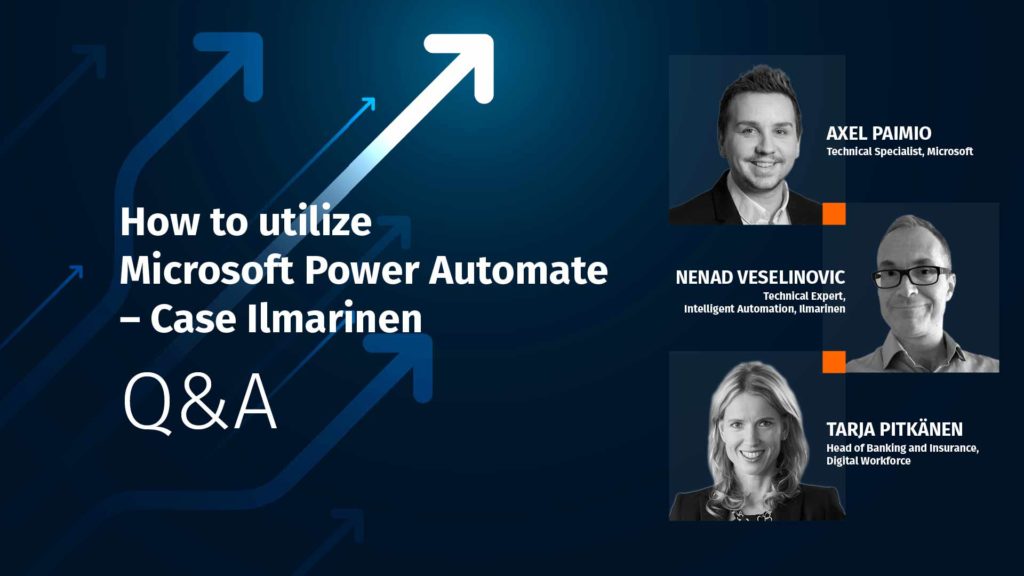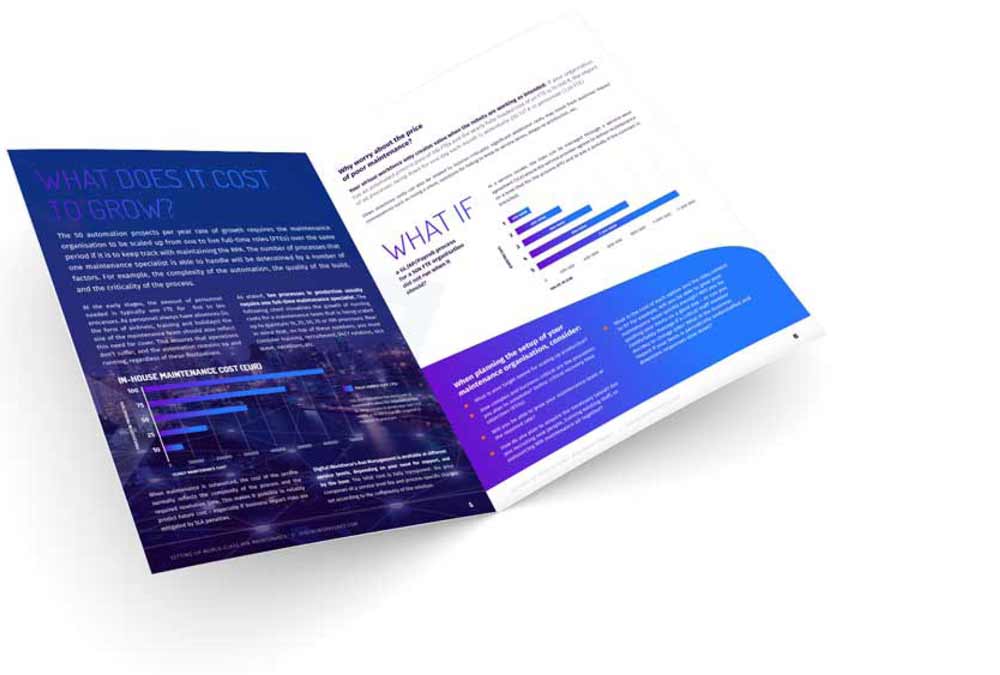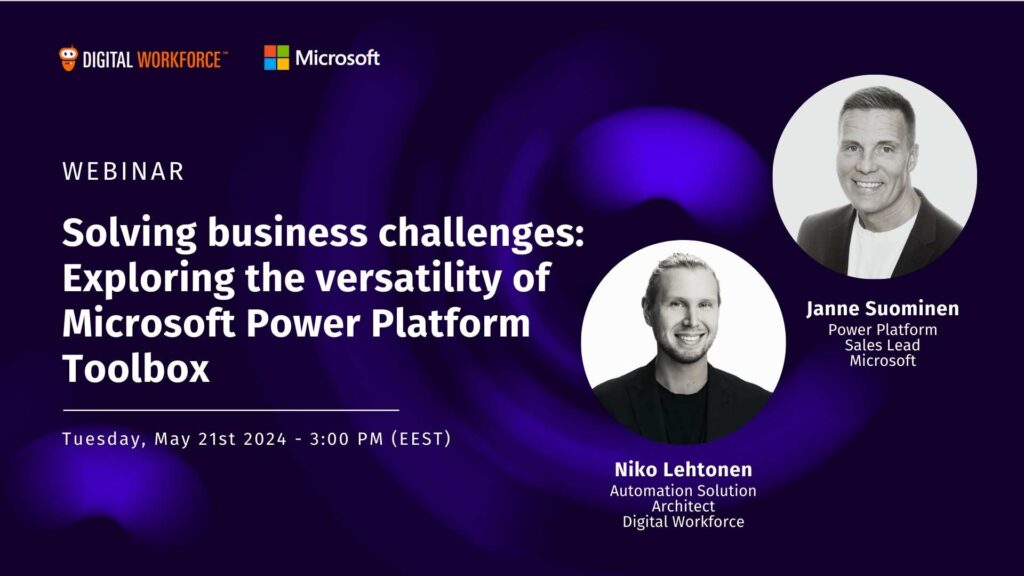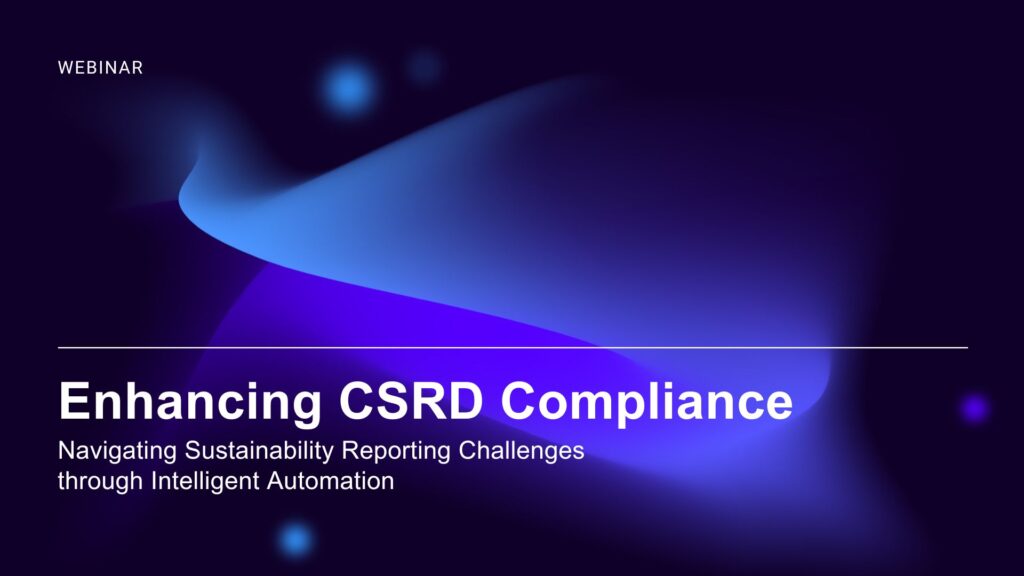Webinar Q&A: How to utilize Microsoft Power Automate – Case Ilmarinen

We recently held a webinar around the topic of Microsoft Power Automate and how Ilmarinen, the biggest employment pension insurance company in Finland, has been utilizing the technology in its mission to reduce mundane manual work and introduce robotics instead. We received lots of great questions during the webinar and since we couldn’t get to all of them during the session, we decided to make a Q&A post covering the questions raised by the audience. In case you missed the webinar, you can see it from the recording any time you want.
Key takeaways from this session include:
- What is Microsoft Power Platform?
- What benefits does Power Automate offer to organizations?
- How has Ilmarinen utilized Power Automate in their daily operations?
Check out below all the answers to the questions about Power Automate and how it can be utilized.
Q&A
A question to Ilmarinen: Your approach was to build an enterprise management model around Power Automate, does that mean, that you have centralized development only? You said that there is also a possibility for citizen developers? How you arranged that in practice?
Nenad / Ilmarinen: IMHO having an enterprise model first is a prerequisite for moving to a citizen model. The citizens can then be constantly guided to operate towards that model by e.g. training and coaching. We can probably never expect the citizens to strictly adhere to all the enterprise model components, but the closer the better. Once the citizen-made application crosses the business criticality and/or usage scale threshold it is anyway time to polish it (or even rebuild it from scratch) according to the enterprise model standards for e.g. reusability. In this way citizen development acts as a catalyzer for scalable innovation which builds on reusability but has sustainable levels of maintenance.
The other way around (starting with a citizen model with a lot of freedom) one might end up with a lot of innovative but siloed/pocket applications mainly for one’s own use. Their composite value then remains limited (unless the scale is really large), as they each have only incremental value, are all done in different ways and with a lot of duplicate work.
I would be interested in what the Finnish insurance company has implemented with Power Automate concretely?
Nenad / Ilmarinen: Without going into too much detail – the cases in question were a very good fit for the API-first approach supported by the existing and custom-made Power Automate connectors.
Question: We use Digital Workforce’s RPA right now. Will Power Automate RPA not interfere?
Tarja / DWF: Power Automate RPA is a low-code product whereas Blueprism and UiPath are designed for more permanent integration and deeper automation scenarios. PA RPA is an interesting complementary tool to tackle certain customer needs and to combine it together with the other existing RPA technologies.
I am part of the coding community. How have other companies chosen to govern their Power Automate capabilities? Is it set up that all employees can have access? Surely we do not want all employees being able to automate sending 100 emails a second.
Axel / Microsoft: Trying to keep the answer short, there are governing models and best practices for the Power Platform on how to set up and control access so you can setup who can do what and in which environments. Please take a look at the tools for governance of the Power Platform here: https://youtu.be/PV4ortF3hR8
Customer telling about their setup here: https://youtu.be/-hwrLa8iV_k
With 370 connections, are we 100% sure there is no data breach through the connections?
Axel / Microsoft: We have tools to set DLP policies around who and which software can use which connectors and through that tune the system to keep business data within the organization and external data separately. Have a look at this walkthrough about setting up DLP and governance: https://youtu.be/t0xUmfjp3Do
Power Automate has its own RPA license. Why should we use Blue Prism/ UI Path?
Axel / Microsoft: UI Path is a Microsoft partner, we work closely with them. Microsoft is aiming to democratize RPA with Power Automate and UI Flows by adding features to it, but still to be able to configure RPA with low-code whereas Blue Prism and UI Path are designed for more permanent integration and deeper automation scenarios that require development skills set up.
Good day. Is Power Automate available on a free version. How easy is it to pick up fo those without previous coding experience? For those with coding experience, does Power Automate have some features that allow developers to ‘express’ themselves?
Axel / Microsoft: Absolutely easy to pick up for pro developers too. There’s a lot of triggers and actions that are ready-made that pro devs can use within the power platform, not needing to start from scratch. For the platform, there is a free version / env from Community Plan. That doesn’t include RPA but includes Power Automate and the building of flows and all other platform features here: https://powerapps.microsoft.com/en-us/communityplan/
RPA features do not come in with the free power platform licenses such as with Office or Teams subscription. But you can start a Power Automate trial and try out the RPA features for a month by choosing “Try Free” at https://flow.microsoft.com/en-us/
Do we have intelligent documentation automation in Power Automate?
Axel / Microsoft: Absolutely. We have AI Builder controls that use Azure cognitive services to read documents and you can build a low-code version of intelligent document automation with Power Automate.
Read more here: https://docs.microsoft.com/en-us/ai-builder/use-in-flow-overview
How well does Power Automate work with non-Microsoft (365) applications?
Axel / Microsoft: Power Automate works very well with 3rd party applications through connectors, which are essentially proxy wrappers around an existing API but so that you a person using low-code can connect to external systems to move data or do other actions. For Power Automate UI Flows (RPA) it works with any win32 application running on Windows 10 or with select Web browsers for the web interface RPA actions. Through Power Automate Desktop we also have ready-made connectors for SAPGUI, Citrix, and other systems from the WinAutomation suite. Here’s a list of Power Automate connectors to use with PA workflows: https://flow.microsoft.com/en-us/connectors/
Hello! Can Power Automate (RPA capabilities) be used to automate any web-based / desktop applications or ONLY MS Dynamics / Office based applications? Thank you!
Axel / Microsoft: Yes, all win32 applications, the only requirement is to have Windows 10 as the OS and Web applications require Chromium browser. https://docs.microsoft.com/en-us/power-automate/ui-flows/overview
Could you explain what the License by flow means?
Axel / Microsoft: Per-flow licensing is a licensing model meant to license one workflow with Power Automate instead of using the per-user licensing model, where a user is licensed and with a per-flow model, you are licensing the workflow.
How would you compare your solution with Blueprism or UI Path? What is your competitive advantage?
Axel / Microsoft: UI Path is a Microsoft partner, we work closely with them. Microsoft is aiming to democratize RPA with Power Automate and UI Flows by adding features to it, but still to be able to configure RPA with low-code whereas Blue Prism and UI Path are designed for more permanent integration and deeper automation scenarios that require development skills to set up. Also, we have priced the unattended bot scenarios competitively and have native integrations to all Microsoft products, so if you’re using Office tools or Teams or building stuff in Azure we have connectors available for our ecosystem and 3rd parties too.
Where do you see the difference between Power Automate and Zapier or Integromat?
For Power Automate workflows, feature-wise pretty much the same. But we keep adding RPA features and native connectors to Microsoft products and SAP and others to easily connect to any available system or use a custom connector if there’s not one available. That and price. It’s much of a consolidation question which way to go. If you’re using Microsoft 365 cloud or building on Azure, then it makes sense to use Power Automate and the Power Platform to transform processes. We are empowering low-code devs not with just a tool, but with a set of tools and a platform so I’d say that’s the biggest difference.
How about Data security and GDPR Compliance?
Axel / Microsoft: We have the tools to govern the Platform and a database (Microsoft Dataverse) with a security model. Microsoft tools in the cloud are all built to support GDPR compliance, obviously, the entity using those tools is responsible for configuring the tools in a GDPR compliant way.
Read more on Microsoft and GDPR at https://www.microsoft.com/en-us/trust-center/privacy/gdpr-overview
Watch a short video of the tools on how to govern the Power Platform: https://youtu.be/PV4ortF3hR8
If you have any questions regarding the topics discussed in the webinar, feel free to contact us for more information.
Kind regards,
Tarja Pitkänen
Head of Banking and Insurance, Digital Workforce
Mobile: +358 50 3516131
Mail: tarja.pitkanen@digitalworkforce.com
More webinars
New guide!
Setting Up World-Class RPA Maintenance
Why you need it and how to set it up




